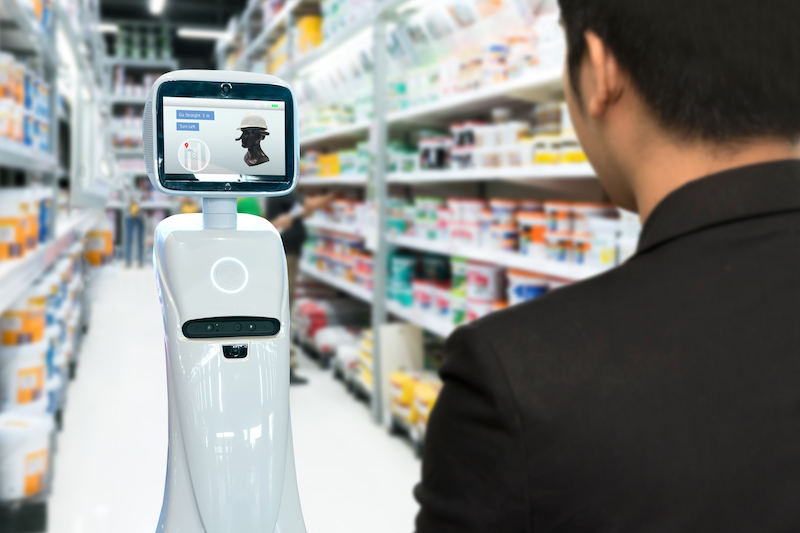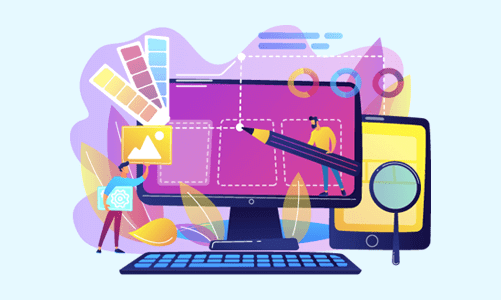Robots have rolled into retail, from six-foot-tall free-moving machines spotting spills in Giant Foods Stores to autonomous shelf-scanners checking inventory in Walmart. At Lowe’s, the house improvement chain, a “LoweBot” in some stores can answer simple questions, like where to seek out items, and may assist with inventory monitoring. These robots release workers from routine tasks, presumably giving humans longer for customer interaction — but that’s only the start.
The real advantage of retail robots is that the opportunity to capture more granular data about the products on the shelves and customer buying patterns, which may increase efficiency and accuracy in inventory management. The key’s using retail robots as data-collectors within an internet-of-things (IoT), which is best thought of as a posh network of connected devices, objects, and sensors gathering voluminous data that’s analyzed within the cloud or with edge computing, which uses nearby servers to lower latency. From manufacturing to transportation and now retail, IoT creates an intelligent digital ecosystem. When combined with the advanced capabilities of AI and machine learning, IoT helps to propel the promise of the Fourth technological revolution to vary how we live, work, conduct business, and buy the products and services we would like and wish.
Buffet Catering Service Gravesend Try this link for any catering purpose.
With robots in stores, retailers have already got the beginnings of a holistic IoT solution. for instance, Auchan Retail Portugal, an outsized European grocery retailer, is launching autonomous shelf-monitoring technology, which uses robots, in its supermarkets and hypermarkets. because the robots move around the stores, they capture photos of each shelf and aisle, which are then digitized and converted into metrics and insights about out-of-stock merchandise and pricing.
Such detailed data is incredibly valuable in retail, where understanding and anticipating consumer demand is important. for instance, Stitch Fix, which provides just-for-you clothing choices to shoppers reception, touts its data science in multiple facets of its business model, from product recommendation to inventory management and fashion design. For traditional retailers, however, merely tracking what consumers purchase doesn’t paint the whole picture. the important competitive advantage for retailers comes in knowing what they couldn’t purchase but wanted to. That’s where robots within the aisles are available.
Gathering Data at the highest of the Marketing Funnel
Robots roaming stores gather data at the “top of the funnel” supported what’s — and isn’t — on the shelves. Their continuous scans provide a more holistic view of customers’ retail experiences. for instance, shelf inventories reveal what’s available in ample quantities, what’s dwindling in supply, and what’s out-of-stock — all of which indicate consumer preferences and action.
In the not-too-distant future, robots could also be ready to do quite a report on inventory levels and perform price checks to make sure accuracy and consistency. Consider a hypothetical scenario of a retail robot scanning grocery aisles and detecting that supplies of sugar-free spread are diminishing at twice the speed of normal spread. That real-time discovery then triggers an automatic order for more sugar-free spread to be sent to a selected store. By detecting sudden and unexpected shifts in inventory, the robot would be ready to respond quickly without human intervention. That’s not unlike what happens in high-frequency trading, which uses algorithms to detect and maximize the tiny, momentary discrepancy available prices, which may aggregate into huge profits over time.
For retailers, the cash to be made immediately is in avoiding these inventory aberrations that cause out-of-stocks, which have an enormous tag — a whopping $1 trillion worldwide, consistent with industry estimates. additionally, to lost sales, customers are disappointed by out-of-stocks, which may cause diminished shopper loyalty.
During the Covid-19 pandemic, home essentials like toilet tissue and cleaning supplies have had widespread out-of-stocks. Retailers eventually imposed limits on purchases per visit, but not before facing chronically empty shelves. But what if retailers had been ready to get an early indication of mass purchases of products like toilet tissue? If a robot within the aisle had detected an unexpected decline in toilet paper supplies, that would have led to raised inventory management early, with increased shipments from warehouses and limits on purchases to quell hoarding.
One of the best catering companies: Buffet Catering Company Gravesend
Using IoT to enhance Other Industries
Advance detection of low inventory and out-of-stocks also can help improve efficiency and customer experiences in other industries, like aviation. for instance, unexpected airplane maintenance can delay flights, not only due to the sudden got to make a repair but also if the specified part or component isn’t available. Using an IoT approach to aircraft maintenance would mean better inventory management of parts and other supplies, and potentially the potential for the aircraft itself to signal a requirement for repair or replacement before the plane is taken out of service. Using sensors and AI for predictive modeling and maintenance is already being explored in applications from manufacturing to water systems.
Robotics has made inroads into numerous industries for years, from automotive assembly operations to robotic arms that lift heavy items in warehouses. In some hotels, robots carry luggage and act as digital concierges. More recently, thanks to the pandemic, robots have rolled into hospitals with nonsurgical applications like sanitizing corridors and rooms and delivering supplies, including blood samples to be tested within the lab. Autonomous robotic cleaners also are making their way into commercial spaces from office buildings to airports.
Until recently, robots in retail have mostly worked behind the scenes. for instance, Amazon uses robots in its fulfillment centers to enhance efficiency also as safety (robots can’t get hurt moving heavy pallets); Amazon says robots have helped it store 40% more inventory in its centers. Meanwhile, Kroger, the most important grocery retailer within the U.S., is launching a network of automated warehouses that use robotics and digital technology to enhance its ability to satisfy customer demands.
Rethinking Retail
In this hyper-competitive industry, during which margins get squeezed across brick-and-mortar, online, and omnichannel competitors, retailers must still believe innovation and technology to differentiate themselves and improve their chances of survival. one among the first waves of retail innovation was e-commerce. While few new trends now, e-commerce did make further inroads due to the pandemic as more shoppers stayed home and purchased online with greater frequency. In fact, the pandemic may have accelerated the shift from physical stores to digital shopping by the maximum amount of five years.
Retail innovators even have been rethinking brick-and-mortar to showcase products and provide consumers a chance to experience new offerings. Now, the newest tread on the trail toward greater innovation is propelling retailers deeper into IoT to enhance inventory management and predictive modeling.
As product cycles speed up, retailers will get to become even more agile in identifying microtrends in consumer behavior to supply, distribute, and provide the products and services that customers want immediately. The key thereto all may alright be a robot roaming freely, bringing data from the buyer touchpoint within the store aisle into the info management system within the cloud.




